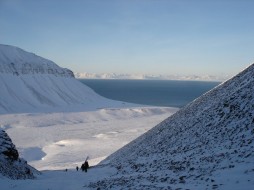From Earth to the Solar System: Svalbard
Life at the top of the world: Svalbard is a remote archipelago in Northern Norway, deep within the Arctic circle. Scientists with the Arctic Mars Analog Svalbard Expedition (AMASE) traveled there to test the protocols, procedures, and equipment needed to detect traces of organic chemistry and perhaps life on Mars. Instruments that will fly onboard NASA’s Mars Science Laboratory and ESA’s ExoMars missions were tested in Svalbard by the AMASE team. With a unique combination of volcanoes, hot springs, and permafrost, the Bockfjord Volcanic Complex on Svalbard is the only place on Earth with carbonate deposits identical to those found in the famous Martian meteorite ALH84001. What a unique opportunity to study the interaction between water, rocks, and primitive life forms in a Mars-like environment! Image Credit: Kjell Ove Storvik/AMASE
T rek across a glacier: Scientists with NASA’s Spaceward Bound Program traveled to the Norwegian archipelago of Svalbard, deep within the Arctic circle, to explore glaciers and glacially-created terrains as analogs for Mars. By investigating glacial landforms on Earth, scientists can learn how past and present glaciation may preserve evidence of life, and apply that knowledge to the search for life within similar geologic features on Mars. Image Credit: Jon Rask
Posted: 5 August 2011
- Categories:





